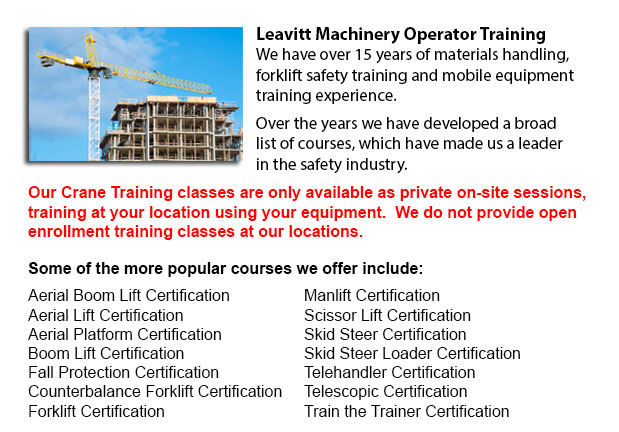
Langley Overhead Crane Operator Training - Our overhead crane operator training course is meant to teach workers the basics of overhead crane/sling operation and pre-shift checks. Programs are taught by our expert trainers and consultants. Well-trained employees are more efficient and productive, which saves on expenses associated with property damage, product damage, and accidents because of the utilization of incorrect operating measures. Our overhead crane certification is customized for workers who have literacy barriers, reducing certification time by 50 per cent.
Overhead cranes are suitable for specific repetitive lifting activities. This type of crane has wide ranging capacities. They may be utilized for specialized lifting tasks like for instance installing or removing major plant machinery.
In order to safely operate an overhead crane, personnel have to employ safe rigging practices. This requires both practice and knowledge. The load should be rigged correctly to be able to ensure its stability when raised. Before starting a lifting job, it must be determined that the crane is suitable for the task, with correct capacity, travel and lift. The crane has to be subjected to a thorough visual and physical check before use. The capacity of all machines, including the hardware, rope and slings, must never exceed load weight capacities.
Before using the rigger needs to know which sling is best for each lift and be able to inspect the rigging gear and hardware. The communications which are utilized with the crane operator should be concise and clear. A signaler has to be designated for the role and signals should be agreed upon. The crane operator must follow instructions only from the chosen individual. If a remote or wired controller is being used, the operator must be trained in all its functions.
In order to ensure the safety of workers, a warning should be issued and the path of the load must be cleared of all obstacles before the lift begins. Individuals must not be allowed to walk underneath the lift loads. The crane hoist needs to be centered over the load prior to lifting to prevent swinging. The safety catch should be closed immediately after sliding the sling entirely onto the hoisting hook. Unused sling legs should be secured so they do not drag. Never leave loose materials on a load being lifted. Watch that hands and fingers are clear when slack is taken out of a sling. Step clear of the danger zone before the lift is made.
-
Operator Safety Certification | Re-Qualification Certification | In-House Instructor Certification in Langley
Lift trucks are utilized in nearly all warehouse operations and in boat yards and in industrial construction sites. The reach feature of a forklift is a vital component used in several applications like for example whenever a shelving system is being... More -
Skid Steer Loader Certification in Langley
The engine powered skid-steer loader consists of a small and rigid frame, equipped along with lift arms that could connect to numerous industrial attachments and tools to carry out several labor saving jobs. Normally, skid-steer loaders are four-whee... More -
Langley Forklift Training Classes
Langley Forklift Training Classes - Forklift are heavy pieces of industrial machines that are utilized in transporting and the handling of merchandise and materials. They are often known as Lift trucks and are found in all kinds of industries. Employ... More -
Langley Heavy Equipment Operator Certification
Langley Heavy Equipment Operator Certification - The heavy equipment operator is an individual who manipulates the controls and drives various kinds of big machinery. Heavy machines is most commonly used on construction sites in order to deliver supp... More -
Langley Crane License
Langley Crane License - Crane operators ought to be "credentialed", which means they ought to own a crane operator license or certification. Credentialing is considered a mandatory governmental prerequisite to be able to practice as a crane operator.... More -
Langley Forklift Training School
Langley Forklift Training School - Forklift Training School And What It Truly Has To Provide - Industry and federal regulators have established the criteria for forklift safety training according to their current standards and regulations. People wis... More -
Langley Boom Lift Certification
Langley Boom Lift Certification - Elevated work platforms allow maintenance operations and work to be performed at heights that can not be reached by whichever other way. Workers utilizing boom lifts and scissor lifts could learn how to safely operat... More -
Langley Manlift Safety Training
Langley Manlift Safety Training - Manlift operators need to be cognizant and aware of all the potential dangers which are connected with specific classes of scissor lifts. They have to be able to operate the scissor lift in a way that protects not on... More

Forklift Certification Langley
TOLL FREE: 1-888-254-6157
Langley, British Columbia
forkliftcertificationlangley.com
Email Us
About Us


